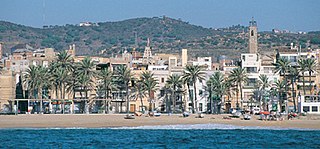
Badalona is a municipality in Barcelonès county, in Catalonia (Spain). It is located to the north east of Barcelona, on the left bank of the Besòs River and on the Mediterranean Sea, in the Barcelona metropolitan area. By population, it is the third largest city in Catalonia and the twenty-third in Spain. It became a city in 1897.

Benabarre, in Ribagorçan and Aragonese: Benavarri is a town and municipality in the Aragonese comarca of Ribagorza, in the province of Huesca, Spain.

Ribagorça or Ribagorza is a historical and natural region of Aragon and Catalonia. Located in the Pre-Pyrenees and Pyrenees area, most of its territory is mountainous. The region has been steadily losing population since mid 20th century.

The Senyera is a vexillological symbol based on the coat of arms of the Crown of Aragon, which consists of four red stripes on a yellow field. This coat of arms, often called bars of Aragon, or simply "the four bars", historically represented the King of the Crown of Aragon.
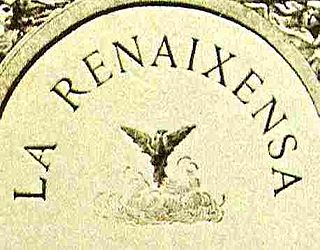
The Renaixença, or Catalan Renaissance, was a romantic revivalist movement in Catalan language and culture through the mid 19th century, akin to the Galician Rexurdimento or the Occitan Félibrige movements. The movement began in the 1830s and lasted until the 1880s, when it branched out into other cultural movements. Even though it primarily followed a romantic impulse, it incorporated stylistic and philosophical elements of other 19th century movements such as Naturalism or Symbolism. The name does not indicate a particular style, but rather the cultural circumstances in which it bloomed.

El Papiol is a municipality in the comarca of the Baix Llobregat in Catalonia, Spain. It is situated on the left bank of the Llobregat river, on the A-7 autopista from Valencia to La Jonquera and the C-1413 road from Sabadell to Molins de Rei. At West it borders on Castellbisbal and Pallejà, at North on Valldoreix and at East on Molins de Rei. It is served by the Renfe railway line R4 from Barcelona to Martorell, Vilafranca del Penedès and Sant Vicenç de Calders, which is connected to the village center by a minibus service. It is also served by a bus service (L67) and a night bus service (N51) from Barcelona to Esparreguera.
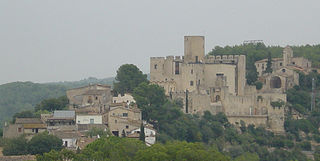
Castellet i la Gornal is a municipality in the comarca of the Alt Penedès in Catalonia, Spain. It is situated in the valley of the Foix river at the point where it crosses the Coastal Range. The river is dammed to form the Foix reservoir. The ajuntament is in La Gornal. The municipality is served by the N-340 road, and by a local road to Vilanova i la Geltrú.
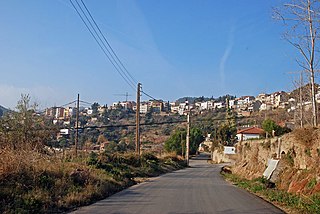
Sant Feliu de Codines is a municipality in the comarca of Vallès Oriental, Catalonia, Spain. It is located in the north-west corner of the comarca, on the border with comarca of Moianès to the north, and the comarca of Vallès Occidental to the west.

Via Laietana is a major thoroughfare in Barcelona, Catalonia, Spain, in the Ciutat Vella district. The avenue runs from Plaça Urquinaona to Plaça d'Antonio López, by the seafront, and separates the neighbourhoods of the old city it has on either side: La Ribera/El Born and Sant Pere on one and Barri Gòtic on the other. It is lined with numerous examples of Modernista, Art Déco, and Noucentista neo-classical architecture, and historically hosted the headquarters of a number of banks, as well as other institutions.
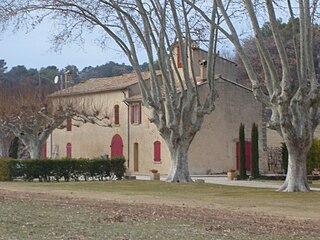
A mas in the Provence and Midi; masia in Catalonia, Balearic Islands, the Land of Valencia and Sardinia; or masía (Spanish pronunciation:[maˈsia] in Aragon is a traditional farmhouse.

Joan Margarit i Consarnau was a Catalan poet, architect and professor. Most of his work is written in the Catalan language. He won the 2019 Miguel de Cervantes Prize.
Plaça de Gal·la Placídia is a square split between the districts of Gràcia and Sarrià-Sant Gervasi, in Barcelona, Catalonia, Spain. Its exact location is between Travessera de Gràcia, Carrer de Neptú, Carrer de Milton, Carrer de l'Oreneta and Via Augusta.

Les Tres Torres is a residential neighbourhood in the inland Sarrià-Sant Gervasi district of Barcelona, Catalonia (Spain).

Mont-roig del Camp is a town and municipality in the comarca of Baix Camp in Catalonia. It is in the middle of its comarca, between the Serra de Colldejou and the Mediterranean Sea. It includes two populated places: the historic town of Mont-roig del Camp in the interior, whose economy revolves round the cultivation of nuts and olives, and the beach resort of Miami Platja on the coast, the Costa Daurada.

L'Ametlla del Vallès is a village in the province of Barcelona and autonomous community of Catalonia, Spain. The municipality covers an area of 14.24 square kilometres (5.50 sq mi) and the population in 2022 was 9,020.

Senterada is a village in the province of Lleida and autonomous community of Catalonia, Spain. The municipality includes a small exclave to the north.
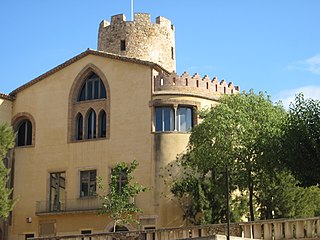
The Balldovina Tower Museum of Santa Coloma de Gramenet in Catalonia, Spain, is a local pluridisciplinary museum, the aim of which is to protect, conserve, study and disseminate the cultural and natural heritage of the territory. The museum, which is part of the Barcelona Provincial Council Local Museum Network, looks after its own collections as well as the monumental heritage of the town of Santa Coloma.

Jaume Aiguader i Miró was a Spanish medical doctor, writer, social activist, politician and Catalan nationalist. He was one of the founders of the Republican Left of Catalonia political party. He became Mayor of Barcelona, and was a national deputy during the Second Spanish Republic. He was Minister of Labor and Social Assistance in the government of Juan Negrín during the Spanish Civil War (1936–1939). After the fall of the Republic, he died in exile in Mexico.
Alberto Porta y Muñoz is a Catalan artist who has been known by the pseudonyms Zush (1968–2001) and Evru (2001–present). Porta is known for his early use of digital technology within his works and his style often presents art as a cathartic and therapeutic process, accessible to all. He was a forerunner in the implementation and normalization of art therapy, having coordinated workshops for mental patients in public institutions of fine art such as Barcelona Museum of Contemporary Art.




























